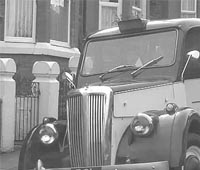| Past,
Present and future? Many years ago when the last of the pre-WW2 old-fashioned Austin, Morris and Beardmore taxis were no more to be seen on the ranks, it left just Carbodies FX3. Some, well actually very few of us, among the 9,000 or so of London’s then-taxi drivers wondered if we’d ever see a PCO approved taxi to compare to a modern, up-to-date car of the late 1950s? In those days it would have meant a vehicle with four doors, some form of warm air heater controlled from the driver’s compartment, windscreen washers and a cabin that was free of draughts? Well, along came the FX4 and various updated versions of the same. A mere 35 or so years later and the TX1, TX11 and now TX4, which although much more modern in appearance and design, still largely use the same basis of separate body and chassis bolted together. This did give to a lesser or greater degree a more modern vehicle in several aspects, though the TX series still lag behind conventional modern automotive practice. What all these LTI purpose-built taxis have in common is that use of a separate body mounted on a separate chassis. Bear in mind that about 97% of all cars made since the 1960s, including even those by Rolls Royce, had been designed and built utilising single shell, monocoque structures. This means a platform and bodywork joined together to form a single basic unit, so sharing and spreading the structural loads and stresses throughout the whole of the inner structure of the vehicle. Outer panels are then attached onto this inner structure to give the outward body style and shape. But the really important thing is that none of these facts, good or bad, about our world famous, iconic London taxis |
"Sunset Strip" has now handed his badge and bill back to the PCO after 50 years - much of it with ODRTS. These are his memories… FIFTY GREEN YEARS… |
|
 Beardmore - it just needed a draught-free cabin with heater
matter a damn! |
because
they were fed up waiting for a bus! The silly thing is that so-called clean hybrids often spend most of their time powered by petrol engines and not the electrical power so talked about, except for short periods when moving at very low speeds. They can only travel a short while before the petrol engine has to start up to drive the alternator to recharge the battery as it runs down. At low speed, I have been informed the maximum distance a Toyota Prius can travel is 1 kilometre. Their exemption from congestion charging is being taken away from the Prius and other car size hybrids in the near future, according to a notice from TfL. So I have a strong feeling that once again London’s cab trade will be used as unpaid guinea pigs. What rarely happens is that these highly rewarded "experts, consultants and advisors" ask people such as cab drivers, firemen, ambulance and police drivers who have to cope in the real world of dealing with London’s traffic for their ideas and opinions. It isn’t going to get any easier in the coming years to earn a decent living driving in London and we are going to need all the help we can muster. Those of you on a decent radio circuit, such as Dial-a-Cab, have the backing and reputation of that circuit behind you. Those who still feel they want to stay independent of radio circuits or trade organisations such as the LTDA, LCDC etc, I fear you will pay a heavy price in increased stress, aggravation and fines. Sunset Strip |
|
|
|
Powered by NetXPosure |
| Copyright 1997-2008 Dial-A-Cab Ltd, All rights reserved. |